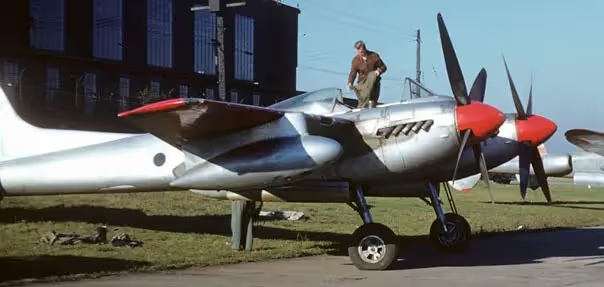Canadian Warplanes 5: de Havilland DH.103 Sea Hornet
de Havilland DH.103 Sea Hornet F.20

(Comox AFM Photo via Mike Kaehler)
de Havilland DH.103 Sea Hornet F. 20 (1), (Serial No. TT193). A single Sea Hornet F 20 (Serial No. TT193) was sent to Edmonton, Alberta, for winter trials in 1948. It was employed with the Winter Experimental Establishment (WEE) flight for winter testing at Watson Lake that year. When it was retired it was sold to Spartan Airways, Reg. No. CF-GUO. It was the only civilian Sea Hornet and the only one to operate outside of the UK. Spartan traded CF-GUO to Kenting Aviation because it was going to stick with using Lockheed P-38 Lightnings. On 11 June 1952, an engine failure caused a forced landing at Terrace, British Columbia. The aircraft was reduced to spares and a large part of it was stored for years. Many thought it had been scrapped but it wasn't and now it is in New Zealand being restored.

(Comox AFM Photo via Mike Kaehler)
de Havilland DH.103 Sea Hornet F. 20 (1), (Serial No. TT193), shown here in the Yukon.
The Hornet was designed with the possibility of naval service on carriers firmly in mind. To this end good low-speed handling was required, along with good all-round visibility for the pilot. The basic Hornet design excelled at meeting these requirements. Shortly after the first Hornet prototype flew, Specification N.5/44 was issued to de Havilland, covering the modification of the Hornet for naval service. The Heston Aircraft Company was contracted to carry out the conversion work on three early production F.1s. The work entailed altering the wings to incorporate folding mechanisms so that each outer wing panel, from the aileron/flap line outboard could be folded upwards and inwards at an angle. The hinges were part of the upper wing skin structure while the lower wing skins incorporated securing latches, and Lockheed hydraulic jacks were used to move the wing panels. Slotted flaps were introduced to improve low speed "flaps down" control.
The lower rear fuselage was reinforced with two additional spruce longerons designed to take the stresses imposed by the external "vee" framed arrestor hook, which was flush-mounted below the fuselage. The frame was made up of steel tubing with a forged-steel hook and was held against the fuselage by a "snap gear". Because the Hornet used the American "3-point" system of catapult-assisted takeoff, two forged steel catapult bridle hooks were fitted, one below each wing, close to the fuselage. The de Havilland rubber-in-compression undercarriage legs could not absorb the rebound energies imposed by carrier landings. They were replaced by more conventional hydraulic oleos which embodied torque links.
Merlin 133/134s (derated from 2,070 hp (1,540 kW) to 2,030 hp (1,510 kW)) were fitted to all Sea Hornets. Other specialised naval equipment (mainly different radio gear) was fitted and provision was made for three camera ports, one on each side of the rear fuselage and one pointing down. Sea Hornet F.20s also incorporated the modifications of the Hornet F.3, although the internal fuel capacity was 347 Imp gal (1,557 l), slightly reduced from that of the F.1. The modifications added some 550 lb (249 kg) to the weight of the aircraft. Maximum speed was decreased by 11 mph (18 km/h).
The Hornet NF.21 was designed to fill a need for a naval night fighter. Special flame-dampening exhausts were installed, and a second basic cockpit was added to the rear fuselage, just above the wing trailing edges. ASH radar equipment was placed in the rear of this cockpit, with the radar operator/navigator seated facing aft. To gain access, a small trapdoor was provided in the lower fuselage; a fixed, teardrop-shaped bubble canopy, which could be jettisoned in an emergency, provided a good field of view. At the front of the aircraft, the nose underwent a transformation with the small rotating ASH radar dish being housed under an elongated "thimble" radome. The horizontal tail units were increased in span. The effect of these modifications on performance was minimal; about 4 mph (6 km/h). (Wikipedia)

(Library and Archives Canada Photo, MIKAN No. 4247977)
de Havilland DH.103 Sea Hornet F. 20. RN Serial No. TT193. Spartan Air Services Ltd, Ottawa, Ontario.

(Nigel Albright Photo)
de Havilland DH.103 Sea Hornet F. 20, RN (Serial No. TT193).

(Comox AFM Photo via Mike Kaehler)
de Havilland DH.103 Sea Hornet F. 20, RN (Serial No. TT193).

(Comox AFM Photo via Mike Kaehler)
de Havilland DH.103 Sea Hornet F. 20, RN (Serial No. TT193). No. 1 engine shutdown and the prop feathered.
.avif)
(Larry Farley family Photo)
de Havilland DH.103 Sea Hornet F. 20, RN (Serial No. TT193), Edmonton, c1950.
.avif)
(Larry Farley family Photo)
de Havilland DH.103 Sea Hornet F. 20, RN (Serial No. TT193), Edmonton, c1950.

(RAF Photo)
de Havilland DH.103 Sea Hornet F. 20, RN (Serial No. PX393), coded SH-W, RAF.





